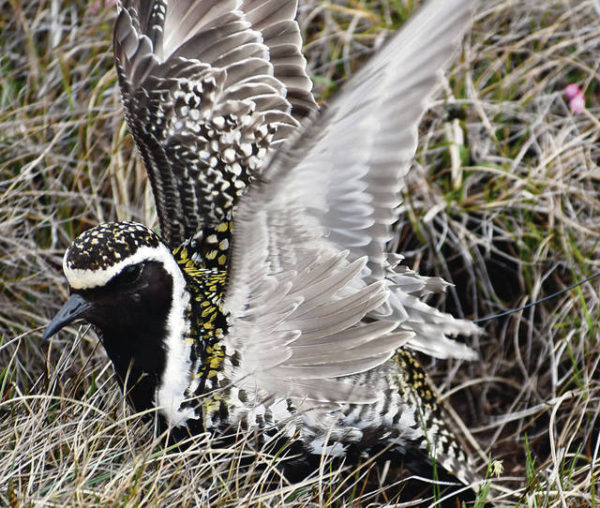Published in the Ocean Watch column, Honolulu Star-Advertiser © Susan Scott
June 23, 2018
NOME, ALASKA >> When I told kolea researcher Wally Johnson that I wished I could spend my summer solstice birthday in Alaska, he invited me to join his plover study team. With my husband’s encouragement, we cut our Australia voyage short, and like Hawaii’s favorite shorebird, I flew in three days from Down Under to the Land of the Midnight Sun.
Pacific golden plovers belong to two identical-looking populations that nest in different parts of Alaska. Wally knows from previous studies that Hawaii’s kolea nest south of here in a tundra area so remote you need a private plane to get there.
 This flapping male plover was trying to divert our attention from his nest.
This flapping male plover was trying to divert our attention from his nest.
©2018 Susan Scott
Due to the mining industry, Nome’s surrounding tundra has roads, making it an accessible place to study the plovers that spend their winters in the Southern Hemisphere. During my travels I’ve seen plovers in Palau, Tahiti, Tonga and Australia.
Because the small birds can’t carry enough body fat to fly from the South Pacific to the Arctic (some go to Siberia), this group refuels in Japan’s rice fields. The farmers don’t mind because the birds eat insects.
Last summer Wally and his team placed GPS monitors on eight males here in the Nome area. The challenge for our team of six last week was to recapture as many of those eight birds as we could find and retrieve their tiny transmitters.
The batteries in each of the $1,500 devices last only a few months but can be recharged and reused — if you can find and recapture the bird.
We knew the vicinity of our target birds because male plovers tend to nest within about 200 yards of their previous year’s nest. Even so, that’s a lot of ground to cover, and finding a nest was like looking for a stickpin in a shag carpet.
The nest and eggs are so perfectly camouflaged that once, I stood not 2 feet from four eggs but didn’t see them until an experienced team member pointed them out.
After hours of walking the wet, buggy tussocks of the tundra to spot a bird and find its nest, we still had to catch the wary dad in a net to relieve it of its backpack.
We found and caught four of the eight birds, a good return for such a project. After removing each of the minuscule transmitters, Wally read the birds’ leg band numbers and checked the data. One instrument had failed, but the other three had done their job.
One bird had come from Papua New Guinea, another from an atoll in the Marshall Islands. The last bird, had, like me, flown here from the east coast of Australia.
Alaska’s wildlife holds endless wonders, including Wally’s special birthday gifts. He placed in my hands two of our charming males, seemingly unaffected by their year of transmitting information about their species. Feeling those little hearts beating through whisper-soft feathers and watching those birds fly free made me happy to be alive. I wish everyone could feel this good about turning 70.